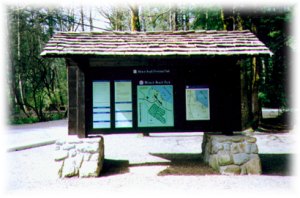 Conceptual
Placement of a New Provincial Campground
Conceptual
Placement of a New Provincial Campground
(1) Conceptual
Outline
(2) Data
Collection
(3) Methodology
(4)
Spatial
AnalysisPart:
one
two three fourfive
six
(5)
Methodological
and Operational
Problems
(6) Cartographic
Model
www.elp.gov.bc.ca/explor/parkpgs/miracle.htm
This project is a spatial analysis of camping in the Vancouver Island region of British Columbia, Canada. Camping is a major recreational activity in British Columbia.Vancouver Island has BC's second highest number of campground visitors, with 580,470 campers in 1999. Currently, Vancouver Island has about 21 Provincial Park campgrounds that provide many amenities.This analysis will consider various provisions that most campsites possess.
The following symbols represent camping provisions:
![]() There are campsites at this park
There are campsites at this park
![]() There are wilderness/walk-in campsites at this park
There are wilderness/walk-in campsites at this park
![]() Group
campsites are available at this park
Group
campsites are available at this park
![]() There is a day-use/picnicking area with picnic tables and a parking area
There is a day-use/picnicking area with picnic tables and a parking area
![]() There is a wheelchair accessible washroom in the park
There is a wheelchair accessible washroom in the park
![]() Cold water taps are located throughout the park. Taps are shut off during
the off season
Cold water taps are located throughout the park. Taps are shut off during
the off season
![]() There
are two flush toilets near the sani-station with pit toilets available
in the campground and day-use areas
There
are two flush toilets near the sani-station with pit toilets available
in the campground and day-use areas
![]() There
are shower facilities at this park
There
are shower facilities at this park
![]() During the collecting season a sani-station/dump is available and a fee
is charged for the service
During the collecting season a sani-station/dump is available and a fee
is charged for the service
![]() Campfire pits are provided
Campfire pits are provided
![]() Electrical hook-ups are not available at provincial parks
Electrical hook-ups are not available at provincial parks
![]() There are regularly scheduled interpretive programs at this park
There are regularly scheduled interpretive programs at this park
![]() There is an extensive trail system in this park
There is an extensive trail system in this park
![]() There
is an adventure playground and sports field at the campground at this park
There
is an adventure playground and sports field at the campground at this park
![]() There are swimming holes at this park
There are swimming holes at this park
![]() There is canoeing/kayaking at this park
There is canoeing/kayaking at this park
![]() There is a boat launch available at this park
There is a boat launch available at this park
![]() There is fresh water fishing and sea water fishing
There is fresh water fishing and sea water fishing
![]() Bicycles must keep to roadways and bicycle helmets are mandatory in British
Columbia
Bicycles must keep to roadways and bicycle helmets are mandatory in British
Columbia
![]() There is horseback riding at this park
There is horseback riding at this park
![]() Pets/domestic animals must be on a leash at all times and are not allowed
in beach areas or park buildings
Pets/domestic animals must be on a leash at all times and are not allowed
in beach areas or park buildings
 Campsites
can be accessed through BC Ferries
which provides service between Vancouver Island, the BC Mainland, and the
Gulf Islands.
Campsites
can be accessed through BC Ferries
which provides service between Vancouver Island, the BC Mainland, and the
Gulf Islands.